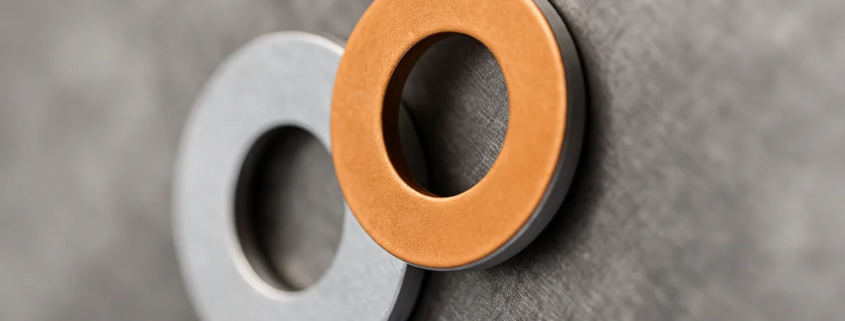Bimetallic washers: uses and applications.
Bimetallic washers are essential components in a wide variety of facilities and industrial sectors. Their innovative design and unique properties allow them to play a critical role in improving the safety, performance, and durability of many applications.
In this post, we will explore in depth the use of bimetallic washers, their operation, benefits and application examples in different sectors.
1.What are bimetallic washers and how do they work?
Bimetallic washers are composed of two different metals with different coefficients of thermal expansion. Generally, aluminum and copper are combined, although other combinations of metals are also used, such as copper and steel. The fundamental principle of operation of bimetallic washers is based on the difference in thermal expansion between the two metals.
When a bimetallic washer is exposed to changes in temperature, the two metals expand or contract at different rates due to their different coefficients of thermal expansion. This results in controlled deformation of the washer, which can be used for specific applications.
2.Benefits of bimetallic washers:
2.1. Compensation for differences in thermal expansion:
One of the main benefits of bimetallic washers is their ability to compensate for differences in thermal expansion between two components or structures. This is especially important in applications where a precise fit and a secure connection are needed between parts that expand or contract with changes in temperature.
2.2. Prevention of galvanic corrosion:
Galvanic corrosion is the result of the following three conditions:
Metals of different nature.
Contact between these metals.
Presence of water and therefore oxygen.
To reduce galvanic corrosion it is necessary to eliminate one of the three conditions. Since it is impossible to suppress metals and water or oxygen present, it is recommended to avoid direct contact between metals of different nature.
Galvanic corrosion is a common problem when dissimilar metals are connected in the presence of an electrolyte, such as moisture. By using a bi-metal washer, galvanic corrosion can be avoided by creating a barrier between the two metals, prolonging the life of the installation and reducing the need for maintenance.
Bi-metal washers placed between grounding/power equipment clamps, cable trays, or flexible grounding braids, and the steel surface on which they are mounted, reduce the effect of corrosion and provide electrical continuity.
The aluminum side of the washer is installed in contact with the steel frame; the copper side is installed in contact with the clamp which is usually made of copper or a copper alloy such as brass.
ASSEMBLY ADVICE: It is essential to check the galvanic compatibility between materials before mounting bimetallic washers on the grounding equipment.
To minimize galvanic corrosion, the best solution is to keep the same material in all the elements of the grounding circuit. However, this mounting criterion is often difficult to achieve.
3. Application examples of bimetallic washers:
3.1. Automotive industry:
In the automotive industry, bi-metal washers are used in applications such as exhaust systems, engines, and suspension components. For example, on exhaust systems, bi-metal washers are placed between the exhaust manifold and the studs to compensate for differences in thermal expansion and prevent leaks.
3.2. Construction and structures:
In construction and structures, bimetallic washers are used in applications such as expansion joints in bridges, buildings, and pipelines. These joints allow structures to expand and contract without causing damage due to temperature fluctuations.
3.3. Electrical industry:
In the electrical industry, bimetallic washers are used in overload protection switches. These washers act as thermal sensors and deform when electrical current exceeds a certain limit, causing circuit disconnection and protecting against damage and possible fire.
3.4. Renewable energy sector:
In the renewable energy sector, bi-metal washers are used in applications such as solar panels and wind towers. In solar panels, bi-metal washers are used to compensate for differences in thermal expansion between the panel and the mounting structure, helping to prevent fatigue and stress damage.
Conclusions of bi metal washers:
The use of bimetallic washers in different installations and sectors offers a wide range of benefits, ranging from compensating for differences in thermal expansion to protection against corrosion and vibrations. These components play a crucial role in improving the performance, safety and durability of many applications, such as the automotive industry, construction, the electrical industry and the renewable energy sector.
With their innovative design and unique properties, bimetallic washers will continue to play a key role in technological evolution and advancement in various areas.
Manufactures Cusell is specialized in manufacturing bimetallic copper-aluminum washers (30% copper+70% aluminum) to order in any size, according to the specific needs of each client or application, and with short delivery times. We manufacture bimetallic washers in a thickness of 1, 1.5 and 2 mm.
Likewise, we can manufacture bimetallic pieces in square, rectangular formats, with or without a central hole, etc.
Ask us about your needs for this type of parts and we will send you a personalized budget, adjusted to your preferences.




